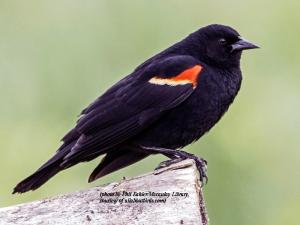The “Say's Phoebe,” which is not usually here this time of year, was spotted on the Agricenter International campus in late February. (Photo courtesy: Andrea Cowart)
According to the Cornell Lab of Ornithology, All About Birds, “The Say’s Phoebe is a slender, long-tailed flycatcher with a relatively large head. It is brownish gray above with a cinnamon belly and gray breast. It perches low to the ground in open country, on shrubs, grasses, barbed wire, etc. It often bobs its tail while perched. (https://www.allaboutbirds.org)
“The Say’s Phoebe is seemingly undaunted by people and often nests on buildings. These open-country birds have cinnamon-washed underparts and a rather gentle expression. They sally from low perches to snatch insects in midair or pounce on them on the ground. Say’s Phoebes often pump their tails while perched on a wire, fence post, or low bush. They breed farther north than any other flycatcher and are seemingly limited only by the lack of nest sites.
“Say’s Phoebes will nest just about anywhere: in mailboxes, on machinery, and even in old nests built by other species.
“Say’s Phoebes don’t come to feeders, but they may use your backyard as a place to catch insects or even build a nest under the eaves of your house or other structure in your yard. A well-placed shelf attached to a building may attract a pair.
“Charles Bonaparte, a nephew of Napoleon, named the Say’s Phoebe after American naturalist Thomas Say, the first scientist to encounter the bird, at a site near Cañon City, Colorado in 1819.”
Find more information about this bird at: https://www.allaboutbirds.org/guide/Says_Phoebe/overview
Red-winged Blackbirds
By Nancy Brannon
I saw the first Red-winged Blackbirds in early March in the wetlands just north of the Loosahatchie River north of Arlington, TN, on the east side of Collierville-Arlington Road. I saw a few sitting atop the tall grasses in the marsh area.
“One of the most abundant birds across North America, and one of the most boldly colored, the Red-winged Blackbird is a familiar sight atop cattails, along soggy roadsides, and on telephone wires. Glossy-black males have scarlet-and-yellow shoulder patches they can puff up or hide depending on how confident they feel. Females are a subdued, streaky brown, almost like a large, dark sparrow. Their early and tumbling song are happy indications of the return of spring.
“You can find Red-winged Blackbirds in the breeding season by visiting cattail marshes and other wetlands, or simply by watching telephone wires on a drive through the country. Where there’s standing water and vegetation, Red-winged Blackbirds are likely to be one of the most common birds you see and hear. Listen for the male’s conk-la-lee! song. In winter, search through mixed-species blackbird flocks and be careful not to overlook the streaky, brown females, which can sometimes resemble a sparrow.”
Find more about red-winged blackbirds at: https://www.allaboutbirds.org/guide/Red-winged_Blackbird/
According to the Cornell Lab of Ornithology, All About Birds, “The Say’s Phoebe is a slender, long-tailed flycatcher with a relatively large head. It is brownish gray above with a cinnamon belly and gray breast. It perches low to the ground in open country, on shrubs, grasses, barbed wire, etc. It often bobs its tail while perched. (https://www.allaboutbirds.org)
“The Say’s Phoebe is seemingly undaunted by people and often nests on buildings. These open-country birds have cinnamon-washed underparts and a rather gentle expression. They sally from low perches to snatch insects in midair or pounce on them on the ground. Say’s Phoebes often pump their tails while perched on a wire, fence post, or low bush. They breed farther north than any other flycatcher and are seemingly limited only by the lack of nest sites.
“Say’s Phoebes will nest just about anywhere: in mailboxes, on machinery, and even in old nests built by other species.
“Say’s Phoebes don’t come to feeders, but they may use your backyard as a place to catch insects or even build a nest under the eaves of your house or other structure in your yard. A well-placed shelf attached to a building may attract a pair.
“Charles Bonaparte, a nephew of Napoleon, named the Say’s Phoebe after American naturalist Thomas Say, the first scientist to encounter the bird, at a site near Cañon City, Colorado in 1819.”
Find more information about this bird at: https://www.allaboutbirds.org/guide/Says_Phoebe/overview
Red-winged Blackbirds
By Nancy Brannon
I saw the first Red-winged Blackbirds in early March in the wetlands just north of the Loosahatchie River north of Arlington, TN, on the east side of Collierville-Arlington Road. I saw a few sitting atop the tall grasses in the marsh area.
“One of the most abundant birds across North America, and one of the most boldly colored, the Red-winged Blackbird is a familiar sight atop cattails, along soggy roadsides, and on telephone wires. Glossy-black males have scarlet-and-yellow shoulder patches they can puff up or hide depending on how confident they feel. Females are a subdued, streaky brown, almost like a large, dark sparrow. Their early and tumbling song are happy indications of the return of spring.
“You can find Red-winged Blackbirds in the breeding season by visiting cattail marshes and other wetlands, or simply by watching telephone wires on a drive through the country. Where there’s standing water and vegetation, Red-winged Blackbirds are likely to be one of the most common birds you see and hear. Listen for the male’s conk-la-lee! song. In winter, search through mixed-species blackbird flocks and be careful not to overlook the streaky, brown females, which can sometimes resemble a sparrow.”
Find more about red-winged blackbirds at: https://www.allaboutbirds.org/guide/Red-winged_Blackbird/








